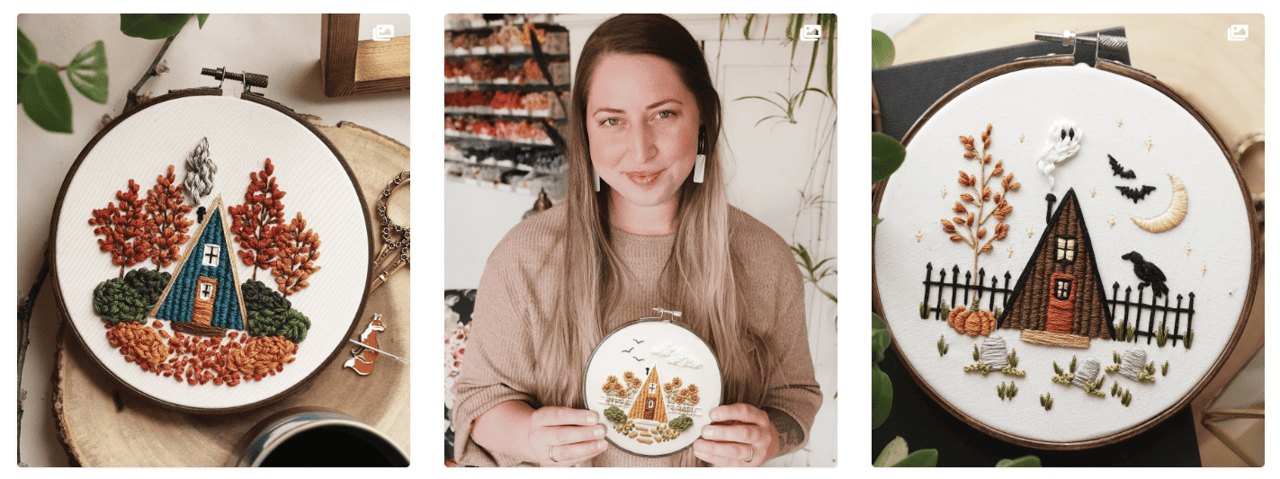Hoop Dreams | Creating Embroidery Keepsakes
Your Home & Lifestyle Magazine
When she was a child, self-taught embroidery artist Chantel Christine recalls her mother encouraged her to do crafts with her siblings at the kitchen table. “My mom fostered creativity. We were always drawing, coloring, and beading,” she remembers. Now Christine, owner of Magnus And Quill Embroidery, has taken those early lessons to another level. A registered massage therapist by trade, she also worked as a professional photographer. “I did weddings and dabbled in a few things,” she explains. “I always said I was going to live a thousand lives, and I’m working on it.”
That philosophy would serve her well in 2020 when the pandemic sidelined her work as a massage therapist—that’s when she came across some embroidery floss at a craft store. “I had never done it before, but the colors are what drew me to it. They were so beautiful and unique,” she says. “I had to google what to do with it. I got some embroidery needles and picked out the colors I liked and some hoops. I used old sheets and pillowcases, and just tried it and fell in love with it.” The discovery was a happy accident that quickly transitioned from hobby to professional endeavor.
For a tight weave, Christine suggests a cotton fabric that doesn’t stretch. “There are other options depending on how detailed you want to be,” she says about the technique. “Embroidery is one of those ancient practices in so many cultures. It’s big all around the world.”
She appreciates the creative process and all it entails, from conception to completion. “During the inspiration stage, the possibilities are endless; I really dive into that,” says Christine. “Embroidery is so therapeutic. I can get lost in countless hours of stitches that just come together, and the color palette just pops. The end result feels very surreal to complete a textured piece and have the satisfaction of having it come to life.”
The patterns she’s created are available for digital download along with embroidery kits that are meant for any skill level. “It doesn’t matter how intricate the design,” she says about her step-by-step embroidery patterns. “I don’t want people to be confused, so I make them foolproof.” The instructions include photos from start to finish and links to YouTube videos for each pattern.
People often tell Christine how much they enjoy the process. “They’re drawn to that need to do something with their hands,” she says. “Touching, creating, and crafting is like an escape from the pressures of this chaotic world. People crave to create art that is calming.”
Her inspirational work depicts serene seasonal scenes that she highlights in her home. “My house is covered in embroidery; I think I have around 200 hoops,” says Christine, who strings them together with clothespins. “There is a main wall that features the seasons. I love to display them in that series. When the snow disappears, I bring out spring.”
The artist likes to mix and match her collections, which feature foxes and bears among other animals. “Magnus is my cat and definitely my fur baby. Everything I do, he gets a cameo in it,” she says about her company’s namesake. (Quill represents the penwork that goes into it.) “I recreate the characters in different scenes, like fall cabins. People love the cabin series. Being such a nature lover, it’s fun to fantasize about a cabin in the woods. It’s very peaceful.”
She also displays some sentimental cross-stitches, like one with a colorful little cat that her mom made. “Knowing how something was made and that every stitch is done with love, I will always have that personal connection, especially with the maker,” says Christine. Although she does not sell her own finished work, she shares it with friends. “If someone has a baby, they’re getting an embroidery.”
Christine has some guidance for others who crave a creative outlet. “Never be afraid to try,” she says. “People are naturally afraid to mess up, but that’s when learning happens. It’s about practice, and everybody starts somewhere. You have to not be in your comfort zone to learn. Have patience, and embrace the calm and the slow, and the trial and error.”
YHL/ Written by Jeanine Matlow
Photography provided by Chantel Christine, Magnus And Quill Embroidery.
